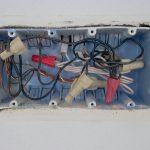To handle flexible cables without tangling, start by choosing the right storage solutions like cable reels or wall-mounted options. Use cable organizers and clips to keep everything neat and accessible. Implement proper coiling techniques, such as the Over-Under Method, to prevent kinks. Avoid stretching or twisting cables by storing them properly. Lastly, label your cables for easy identification. There are more tips that can help you maintain your cables effectively and hassle-free.
Table of Contents
Key Takeaways
- Use the Over-Under Method to coil cables, alternating loop directions to prevent tangling.
- Store cables in gentle loops rather than wrapping them too tightly for easy access.
- Utilize cable organizers and clips to maintain neat arrangements and facilitate efficient routing.
- Avoid overstretching and twisting cables during handling to prevent internal damage and kinks.
- Label cables with clear descriptions to quickly identify their functions and reduce setup time.
Choose the Right Storage Solution
When you're dealing with flexible cables, choosing the right storage solution can make a significant difference in their longevity and usability.
Opt for a storage method that prevents kinks and tangles. Consider using cable reels or organizers designed specifically for flexible cables. These tools keep your cables neatly coiled, making them easy to access when you need them.
Choose cable reels or organizers to keep flexible cables coiled and tangle-free for easy access.
Avoid wrapping cables too tightly; this can lead to wear and damage over time. Instead, use gentle loops that allow for some give.
If you're short on space, look for wall-mounted storage options or compact boxes.
Utilize Cable Management Accessories
To keep your flexible cables tidy, you should consider using cable management accessories.
Cable organizers, clips, and Velcro straps can make a big difference in reducing clutter and preventing tangles.
Cable Organizers and Clips
While managing flexible cables can feel overwhelming, using cable organizers and clips simplifies the process significantly.
These handy tools help you keep your cables neatly arranged and prevent tangling. You can easily attach clips to your desk or walls, allowing you to route cables in a way that's both efficient and visually appealing.
Consider using cable organizers with compartments for different types of cables, making it simple to find what you need quickly.
When you use these accessories, you not only enhance your workspace's aesthetics but also improve your productivity.
Velcro Straps and Ties
Although you might think cable management is just about organizing visible cables, Velcro straps and ties play a crucial role in keeping everything tidy behind the scenes. These accessories help you bundle cables together, preventing tangles and ensuring a cleaner workspace. You can easily adjust them to accommodate different cable sizes, making them versatile and user-friendly.
Here's a quick comparison of Velcro straps and ties:
| Feature | Velcro Straps | Cable Ties |
|---|---|---|
| Reusability | Yes | No |
| Adjustability | High | Low |
| Ease of Use | Easy | Moderate |
Investing in Velcro straps and ties will elevate your cable management game, keeping everything organized and efficient.
Implement Proper Coiling Techniques
When coiling flexible cables, using the Over-Under Method can help prevent tangling and kinks.
It's also important to maintain consistent loop sizes to ensure an even and manageable coil.
Use the Over-Under Method
To keep your flexible cables neat and tangle-free, mastering the Over-Under Method is essential. This technique involves alternating the direction of your loops as you coil the cable.
Start by creating a loop over your hand, then bring the cable under and form another loop. By alternating this way, you prevent the cable from twisting, reducing the chance of tangling.
Remember to keep the loops close together, which helps maintain control over the cable's length. As you practice this method, you'll find it becomes second nature.
Regularly using the Over-Under Method will keep your cables organized and ready for use, ensuring they last longer and perform better when you need them.
Maintain Consistent Loop Size
How can you ensure your cables stay organized and tangle-free? One key technique is maintaining a consistent loop size when coiling. This helps prevent kinks and tangles, making it easier to handle your cables. When coiling, aim for uniform loops—this keeps your cables secure and manageable.
| Loop Size | Benefits | Tips |
|---|---|---|
| Small | Easy storage | Use a cable tie |
| Medium | Versatile use | Keep loops tight but not too tight |
| Large | Quick deployment | Use a bag for transport |
Avoid Overstretching and Twisting
While handling flexible cables, it's crucial to avoid overstretching and twisting them, as doing so can damage the internal wiring. When you pull a cable too tightly, you risk breaking connections or causing shorts. Instead, keep a gentle grip and allow the cable to move freely.
If you notice any knots or tangles, take the time to untwist them carefully, rather than yanking or forcing the cable. This practice will extend the life of your cables and ensure they function correctly.
Always remember to store your cables in a way that prevents twisting, like using cable ties or pouches. By being mindful of how you handle and store your cables, you'll maintain their integrity and performance.
Label and Identify Your Cables
Labeling and identifying your cables can save you a lot of time and frustration later on. When you know what each cable does, you'll avoid the hassle of chasing down the right one.
Labeling your cables can prevent future headaches and streamline your setup process. Knowing each cable's purpose is key.
Here are some tips to help you get started:
- Use color-coded labels for quick identification.
- Write clear, concise descriptions of each cable's function.
- Consider using a label maker for a professional touch.
- Keep a digital inventory of your cables for easy reference.
Regularly Check and Maintain Your Cables
To ensure your cables remain in good working condition, regularly checking and maintaining them is essential.
Start by inspecting your cables for any signs of wear, such as fraying or exposed wires. If you spot any damage, replace the cable immediately to avoid potential hazards.
Keep connectors clean and free from dust, as debris can affect performance. Additionally, store your cables properly when not in use—avoid tightly wrapping them, as this can cause kinks. Instead, use cable ties or organizers to keep them neat.
Finally, make it a habit to test your cables periodically. This proactive approach will help you catch issues early and extend the lifespan of your cables, ensuring they function effectively when you need them.
Frequently Asked Questions
Can I Use Zip Ties for Cable Management?
Absolutely, you can use zip ties for cable management. They help keep your cables neat and organized. Just make sure you don't tighten them too much; you want to avoid damaging the cables.
What Materials Are Best for Cable Storage Solutions?
For effective cable storage, you'll want to use soft fabric pouches, sturdy plastic bins, or dedicated cable organizers. These materials keep your cables safe, tangle-free, and easy to access whenever you need them.
How Often Should I Replace Old Cables?
You should replace old cables every 2-3 years or sooner if you notice fraying, reduced performance, or connectivity issues. Regularly inspecting them helps you maintain optimal functionality and prevent potential hazards in your devices.
Is It Safe to Use Adhesive Cable Clips?
Yes, it's safe to use adhesive cable clips as long as you ensure they're compatible with your surfaces and can support the cable's weight. Just make sure to follow the manufacturer's instructions for best results.
Can I Wash Flexible Cables to Maintain Cleanliness?
Yes, you can wash flexible cables, but avoid submerging them completely. Use a damp cloth to wipe off dirt and grime. Just ensure they're unplugged and completely dry before reconnecting to avoid any damage.




